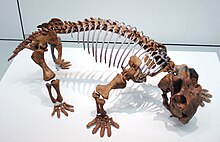Anomodontia
| Anomodonts Temporal range: Middle Permian-Late Triassic, 270–201 Ma (Possible Early Cretaceous record.) |
|
|---|---|
 |
|
| Mounted skeleton of Lystrosaurus | |
| Scientific classification | |
| Kingdom: | Animalia |
| Phylum: | Chordata |
| Order: | Therapsida |
| Clade: | Neotherapsida |
| Suborder: |
†Anomodontia Owen, 1859 |
| Subgroups | |
Anomodontia is an extinct group of non-mammalian therapsids containing many species from the Permian and Triassic periods (possibly continuing into the Early Cretaceous), most of which were toothless, possibly endothermicherbivores. Anomodonts were very diverse during the Middle Permian, including primitive forms like Anomocephalus and Patranomodon and groups like Venyukovioidea, Dromasauria, and Dicynodontia. Of these, only the dicynodonts survived beyond the Middle Permian. Dicynodonts became the most successful and abundant of all herbivores in the Late Permian and Triassic, filling ecological niches ranging from large browsers down to small burrowers. Few dicynodont families survived the Permian–Triassic extinction event, but one lineage evolved into large, stocky forms that remained the dominant terrestrial herbivores right until the Late Triassic, when changing conditions caused them to decline.
Cladogram modified from Liu et al. (2009):
...
Wikipedia
